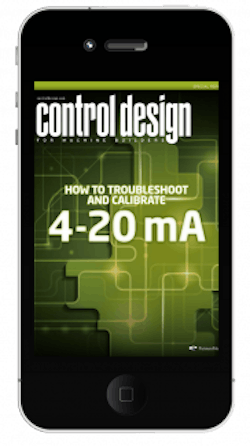Download now.
A Control Design reader writes: We have several temperature, pressure and flow sensors on a new medical-device cleaning skid that we are developing. These instruments are connected to a PLC as 4-20 mA inputs, and there is also a 4-20 mA output used to control a pump motor speed. A recent failure of a flow sensor brought the process skid instrumentation to my company's quality manager's attention. He asked how we know that the temperatures, pressure and flow are accurate, and how do we know that we are cleaning properly.
I've been tasked to write a procedure for troubleshooting, calibrating and testing the 4-20 mA instruments on the skid. I can probably stumble through this, but what are some best practices for troubleshooting the analog circuits to the PLC; how do I calibrate the instruments; and how should I periodically test the devices? Should I add programming to the PLC and HMI to simplify these functions?
ANSWERS
Best practices, calibration and programming
What are some best practices for troubleshooting the analog circuits to the PLC? Once the skid has completed startup and commissioning, there is a limited amount of troubleshooting to maintain the system. If a short in the wiring occurs in the analog wires, you will likely get a blown fuse indication. If an open occurs in the analog wires, you likely have a loose termination and this will be found with continuity checks. For failures in the transmitter, the indication will either be an overdriven signal (>20 mAdc, for example, 22 mAdc) or a signal significantly below zero, such as 3.5 mAdc. The direction the transmitter drives to in a failure mode will depend on whether the transmitter is set up to provide an upscale or downscale burnout (upscale 22 mAdc vs. downscale 3.5 mAdc). The determination of which failure mode to use—upscale or downscale burnout—depends on the use of the transmitter. This selection is made based on making the loop failsafe.
For example, if it is a temperature transmitter and it is used for a high temperature interlock, we would select upscale burnout. In contrast, assume a flow transmitter for controlling the cooling for motor bearings. If we have a flow transmitter failure, we may want to apply full cooling. If so, we would prefer a downscale burnout so that we respond by applying full flow.
How do I calibrate the instruments; and how should I periodically test the devices? Instrument calibration should be performed by a qualified instrument technician. If you choose to self-perform, it may be best to shadow a third-party technician until you have purchased the necessary calibration equipment and learned the skills needed to do the calibrations. Calibration serves as the testing of the devices, and the test or calibration interval is determined by the level of accuracy required for your application. Obviously the higher the required accuracy is, the more often calibration will be required. Typically annual calibrations are sufficient; however, this will need to be determined from experience with this specific equipment and application.
Should I add programming to the PLC and HMI to simplify these functions? No programming is necessary or helpful in simplifying the calibration work; however, good alarming is always helpful in troubleshooting and maintaining a control system. While adequate alarming is important, also consider moderation when applying alarms. If you flood the HMI with too many alarms in an attempt build in troubleshooting intelligence, you will overwhelm the equipment operator. Also, excessive alarms can quickly become a nuisance, so they begin to be ignored. A flood of redundant alarms can also distract from a pertinent or critical alarm that may be missed as a result of overuse.
In addition to a proper calibration interval, quality checks of the signals can aid in detecting a deteriorating transmitter. For example, as a transmitter begins to lose its accuracy, the calibrated span typically shifts above or below zero (4 mAdc). For example, in a flow transmitter, the 16 mAdc span (4–20 mAdc) may still be accurate, but, with zero flow through the sensing element, the transmitter may be sending a signal of 4.3 mAdc. This means that a 20.3 mAdc output may represent full flow instead of 20 mAdc. To detect this condition you may consider doing off-state verification. In short, by monitoring the flow signal when the pump is not running, you will catch an elevated zero as an indication of a need for calibration. The same technique could be used to indicate an improperly calibrated pressure transmitter. A comparison of pump speed to flow and pressure is another means of qualifying the accuracy of these transmitters. It will only detect a gross error, but this may be useful data depending on the application.
— Tim Green, director of field services, Maverick Technologies, www.mavtechglobal.com, Columbia, Illinois
About the Author
Mike Bacidore
Editor in Chief
Mike Bacidore is chief editor of Control Design and has been an integral part of the Endeavor Business Media editorial team since 2007. Previously, he was editorial director at Hughes Communications and a portfolio manager of the human resources and labor law areas at Wolters Kluwer. Bacidore holds a BA from the University of Illinois and an MBA from Lake Forest Graduate School of Management. He is an award-winning columnist, earning multiple regional and national awards from the American Society of Business Publication Editors. He may be reached at [email protected]

Leaders relevant to this article:


